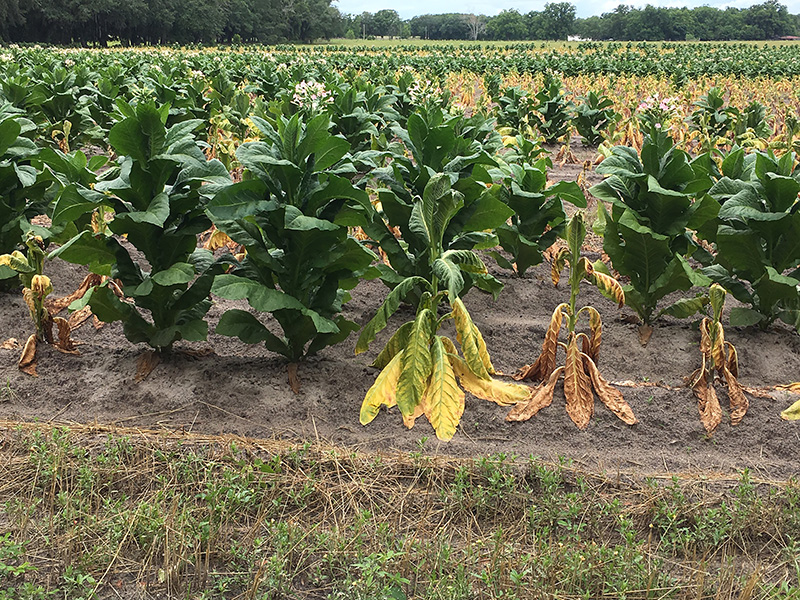Tobacco, once a historically significant crop in Georgia, is a relatively minor agricultural commodity in the twenty-first century. Grown in thirty-five Georgia counties in 2007, tobacco generated a farm gate value (the value of the product when it leaves the farm) of around $65 million, ranking it twenty-seventh in the state’s top commodities for that year. (Cotton was ranked second, with a farm gate value of more than $600 million, and peanuts were seventh, with $382 million.)
Unlike other crops raised for human consumption, tobacco is generally considered to be harmful to human health. As a result, much of the genetics research on tobacco in Georgia centers on the consequences of tobacco use on human health, rather than on improving the agricultural production of the plant. According to the Centers for Disease Control and Prevention (CDC) in Atlanta, 19.3 percent of adults in Georgia smoked in 2007. (The state with the highest percentage of adult smokers in that year was Kentucky, with 28.3 percent, and the lowest was Utah, with 11.7 percent.)
Genetic Modifications for Tobacco Cultivation
During the 1990s researchers at the University of Georgia’s Horticulture Department and the Coastal Plain Experiment Station (later University of Georgia Tifton campus) collaborated on identifying a genetically modified strain of tobacco for resistance to drought and saltwater, but they were not successful. Their findings were published in 1997, and since that time very little research on the genetic modification of tobacco has been conducted in Georgia, although such research has continued in other places, primarily at the University of Arizona.
Genetically Modified Tobacco in Cigarettes
Widely recognized as a center for public health, Atlanta is home to both the CDC and the American Cancer Society. Both institutions research tobacco use and advocate against it. Some of this research involves tobacco that has been genetically modified to contain less of the addictive substance nicotine.

Photograph by Sarah E. McKee, New Georgia Encyclopedia
When the U.S. government began pressuring tobacco companies to encourage smoking cessation, the companies responded with potential reduced exposure products (PREPs). One PREP idea involved removing the nicotine from cigarettes to eliminate their addictive properties. Early methods attempted during the late 1980s involved directly removing nicotine from the tobacco leaves, but doing so caused the cigarettes to taste different. Researchers specializing in genetics realized that if they could turn off the gene that makes tobacco plants produce nicotine, then the plants would be nicotine-free and probably taste the same.
Vector Tobacco, Inc., a tobacco company based in North Carolina, hired geneticist Mark Conkling to create a nicotine-free tobacco strain. Conkling developed and patented a method that alters the plant’s genetic material, or deoxyribonucleic acid (DNA), so that the tobacco will not produce any nicotine in its roots. Since tobacco plants make nicotine in their root systems and transport it to the leaves, the leaves of a plant with this DNA modification will not contain nicotine. (In reality, some nicotine is still present in the leaves, but only in a very small quantity.) The removal of nicotine from tobacco leaves yields a smoking product that is free of any chemically addictive properties, although many other harmful substances are still present.

Photograph from CAES Newsire, University of Georgia
In 2001 Vector began selling Omni cigarettes, the first genetically modified tobacco product on the market. Two years later the company released a new nicotine-free cigarette, Quest, which researchers in Atlanta and elsewhere began testing shortly after its release. In 2008 chemists at the CDC’s National Center for Environmental Health began using Quest cigarettes in experiments involving nicotine content and charcoal filters.
Tobacco and Cancer
Present in all tobacco smoke is a class of harmful chemical compounds called carcinogens, which change human DNA in such a way as to cause cancer. Some examples of carcinogens found in tobacco smoke are 1,3-butadiene, benzene, and vinyl chloride. Although Quest cigarettes do not contain nicotine, the smoke they produce consists of the same carcinogens as regular cigarettes.
In 2002 the American Cancer Society published a report on the relationship between tobacco use and cancer. This report summarizes more than fifty years of tobacco research and explains how advances in molecular biology have allowed geneticists to identify the mutation that initiates tobacco-related cancers. The report also mentions the future of genetics-related cancer research, including the possibility that doctors may one day be able to determine if an individual’s cancer was caused directly by tobacco use.







